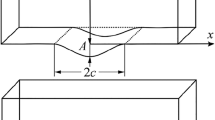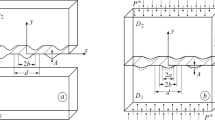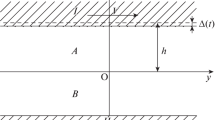We consider contact problems for thin-walled structural elements and their wear. We propose a unified method for solving the problems based on the reduction to Volterra integral equations. This enables us to detect singularities of solutions depending on the hypotheses characterizing the process of deformation of thin-walled elements. We present the solutions and analyze the problems of wear of the plates by a rigid punch and a hot punch with regard for the friction heating and changes in the thickness of the plate in the process of wear.
Similar content being viewed by others
References
V. M. Aleksandrov and G. K. Annakulova, “Contact problem of thermoelasticity with regard for wear and friction-induced heat release,” Tren. Iznos, 11, No. 1, 24–28 (1990).
V. M. Aleksandrov and S. M. Mkhitaryan, Contact Problems for Bodies with Thin Coatings and Interlayers [in Russian], Nauka, Moscow (1983).
V. M. Aleksandrov and М. I. Chebakov, Introduction to the Mechanics of Contact Interactions [in Russian], TsVVR, Rostov-on-Don (2005).
A. A. Amirdzhanyan and A. V. Saakyan, “On forcing of a Π-shaped rigid punch into an elastic half plane with regard for the forces of sliding friction and adhesion,” Izv. Nats. Akad. Nauk Arm. Mekh., 66, No. 3, 3–11 (2013).
A. E. Andreikiv and M. V. Chernets, Evaluation of the Contact Interaction of Machine Parts in Friction [in Russian], Naukova Dumka, Kiev (1991).
Yu. P. Artyukhin, “One-dimensional contact problems of the theory of shells,” Izv. Akad. Nauk SSSR. Mekh. Tverd. Tela, No. 3, 55–65 (1981).
V. V. Aulin and V. M. Bobryts’kyi, “Computer modeling of temperature and stress fields in composite materials and coatings during their formation, friction, and wear,” Zbirn. Nauk. Prats’ Kirovograd. Nats. Tekh. Univ.: Tekh. S.-H. Vyrobn., Haluz. Mashynobud., Avtomatyz., Issue 27, 236–245 (2014).
M. V. Blokh, “Choice of the model in problems of contact between thin-walled bodies,” Prikl. Mekh., 13, No. 5, 34–42 (1977); English translation: Sov. Appl. Mech., 13, 449–455 (1977); 10.1007/BF00901799.
A. A. Bobylev, I. S. Belashova, and S. D. Kuz’min, “Contact problem of forcing of a convex punch into a functional gradient coating by a given force,” Vest. Mosk. Aviats. Inst., 21, No. 3, 151–160 (2014).
F. P. Bowden and D. Tabor, The Friction and Lubrication of Solids, Oxford Univ. Press, Oxford (2001).
N. D. Vaisfel’d, “Collision of an elastic finite-length cylinder with a rigid barrier,” Prikl. Mekh., 43, No. 9, 74–82 (2007); English translation: Int. Appl. Mekh., 43, Issue 9, 1009–1016 (2007).
A. B. Vasil’eva and N. A. Tikhonov, Integral Equations [in Russian], Fizmatlit, Moscow (2002).
I. N. Vekua, Some General Methods of Construction of Different Versions of the Theory of Shells [in Russian], Nauka, Moscow (1982).
A. F. Verlan’ and V. S. Sizikov, Integral Equations: Methods, Algorithms, and Programs [in Russian], Naukova Dumka, Kiev (1986).
L. A. Galin, Contact Problems of the Theory of Elasticity and Viscoelasticity [in Russian], Nauka, Moscow (1980).
G. H. Golub and C. F. Van Loan, Matrix Computations, JHU Press, Baltimore–London (1996).
I. G. Goryacheva, Mechanics of Friction Interaction [in Russian], Nauka, Moscow (2001).
É. I. Grigolyuk and V. M. Tolkachev, Contact Problems of the Theory of Plates and Shells [in Russian], Mashinostroenie, Moscow (1980).
Ya. M. Grigorenko, A. T. Vasilenko, I. G. Emel’yanov, B. L. Pelekh, and A. V. Maksimuk, Statics of Structural Elements, in: A. N. Guz’ (editor), Mechanics of Composite Materials [in Russian], Vol. 8, A. S. K, Kiev (1999).
Ya. M. Grigorenko and N. N. Kryukov, “Solution of problems of the theory of plates and shells with the use of spline functions (survey),” Prikl. Mekh., 31, No. 6, 3–27 (1995); English translation: Int. Appl. Mekh., 31, 413–434 (1995).
D. V. Grilitskii and V. I. Pauk, “A contact problem for a thick rough layer showing wear and heat production,” Fiz.-Khim. Mekh. Mater., 25, No. 3, 78–83 (1989); English translation: Sov. Mater. Sci., 25, 305–310 (1989).
A. N. Guz and V. B. Rudnitskii, Fundamentals of the Theory of Contact Interaction of Elastic Bodies with Initial (Residual) Stresses [in Russian], PP Mel’nik, Khmelnitskii (2006).
K. L. Johnson, Contact Mechanics, Cambridge Univ. Press, Cambridge (1985).
O. V. Zakalov and I. O. Zakalov, Foundations of Friction and Wear in Machines: A Manual [in Ukrainian], Pulyui Ternopil National Technical University, Ternopil (2011).
G. S. Kit and M. G. Krivtsun, Plane Problems of Thermoelasticity for Bodies with Cracks [in Russian], Naukova Dumka, Kiev (1983).
G. S. Kit and A. V. Maksimuk, “Wear of thin-walled structural elements of composite materials with regard for thermal effects,” Mekh. Kompozit. Mater., 35, No. 3, 309–318 (1999).
G. S. Kit and A. V. Maksimuk, “Method of Volterra integral equations in contact problems for thin-walled structural elements,” Teor. Prikl. Mekh., Issue 27, 29–35 (1997).
B. V. Kopei, A. V. Maksimuk, and N. N. Shcherbina, “Analysis of contact stresses in structural joints of a composite shell with steel shroud,” Mekh. Kompoz. Mater., 36, No. 1, 109–120 (2000).
I. V. Kragel’skii, M. N. Dobychin, and V. S. Kombalov, Fundamentals of the Numerical Analysis of Friction and Wear [in Russian], Mashinostroenie, Moscow (1977).
V. D. Kubenko, V. V. Gavrylenko, and Ya. A. Zhuk, “Nonstationary contact problem of the theory of elasticity (conforming and nonconforming surfaces),” Met. Rozv. Prykl. Zadach Mekh. Deformiv. Tverd. Tila, Issue 10, 162–178 (2009).
A. G. Kuz’menko, Reliability of Friction Units in Terms of Strength and Wear [in Russian], Khmelnitskii National University, Khmelnitskii (2011).
R. М. Kushnir, V. S. Popovych, and H. Yu. Harmatii, “Analytic-numerical solution of contact problems of thermoelasticity for thermosensitive bodies,” Fiz.-Khim. Mekh. Mater., 37, No. 6, 39–44 (2001); English translation: Mater. Sci., 37, No. 6, 893–901 (2001).
R. М. Kushnir, V. S. Popovych, and B. V. Protsyuk, “On the development of investigations of the thermomechanical behavior of thermally sensitive bodies,” Mat. Met. Fiz.-Mekh. Polya, 59, No. 3, 7–27 (2016); English translation: J. Math. Sci., 236, No. 1, 1–20 (2019); 10.1007/s10958-018-4094-4.
V. М. Maksymovych, A. Yu. Kotsyuba, and S. V. Lavrenchuk, Plane Contact Problems of the Theory of Elasticity for Bodies of Complex Shape [in Ukrainian], Editing and Publishing Department of the Lutsk National Technical University, Lutsk (2012).
O. V. Maksimuk, “On the problem of wear of thin anisotropic plates,” Mat. Met. Fiz.-Mekh. Polya, 40, No. 3, 125–128 (1997); English translation: J. Math. Sci., 96, No. 1, 2907–2910 (1999); 10.1007/BF02169005.
O. V. Maksymuk, “Dependence of wear of anisotropic plates on their thickness,” Fiz.-Khim. Mekh. Mater., 36, No. 4, 117–119 (2000); English translation: J. Math. Sci., 36, No. 4, 620–624 (2000).
O. V. Maksymuk, “Mathematical model of wear of anisotropic plates by a hot punch,” Probl. Trybol., Issue 5, 53–60 (1997).
O. V. Maksymuk, “On a version of the theory of transversely isotropic plates of varying thickness,” Mat. Met. Fiz.-Mekh. Polya, 43, No. 1, 130–136 (2000).
O. V. Maksymuk, R. M. Makhnits’kyi, and N. M. Shcherbyna, Mathematical Modeling and Methods for Calculating Thin-Walled Composite Structures [in Ukrainian], Pidstryhach Institute for Applied Problems in Mechanics and Mathematics, Lviv (2005).
R. M. Martinyak and R. M. Shvets’, “A mathematical model of mechanical contact of bodies across a thin inhomogeneous layer,” Mat. Met. Fiz.-Mekh. Polya, 40, No. 2, 107–109 (1997); English translation: J. Math. Sci., 90, No. 2, 2000–2002 (1998).
V. I. Mossakovskii, V. S. Gudramovich, V. S. Makeev, Contact Problems of the Theory of Shells and Bars [in Russian], Mashinostroenie, Moscow (1978).
N. K. Myshkin and M. I. Petrokovets, Friction, Lubrication, and Wear. Physical Foundations and Technical Applications of Tribology [in Russian], Fizmatlit, Moscow (2007).
O. V. Nakhaichuk, A. A. Mizrakh, N. O. Pukhtits’ka, and V. I. Muzychuk, “Investigation of the influence of friction on the stressed state in the process of indentation by a rounded indenter,” Probl. Trybol., 78, No. 4, 11–16 (2015).
V. I. Ostrik, “Axisymmetric contact of a punch of polynomial profile with an elastic half space in the presence of friction and adhesion,” Prikl. Mat. Mekh., 77, No. 4, 605–619 (2013).
V. I. Ostryk, Contact Mechanics: A Textbook [in Ukrainian], “Kyivs’kyi Universytet” VPTs, Kyiv (2015).
V. V. Panasyuk and M. I. Teplyi, Some Contact Problems of the Theory of Elasticity [in Ukrainian], Naukova Dumka, Kyiv (1975).
B. L. Pelekh, A. V. Maksimuk, and I. M. Korovaichuk, Contact Problems for Layered Structural Elements and Bodies with Coatings [in Russian], Naukova Dumka, Kiev 1988.
Ya. S. Pidstryhach, Selected Works [in Ukrainian], Naukova Dumka, Kyiv (1995).
I. M. Pistunov, Sliding Friction Units. Models and Optimization [in Ukrainian], National Mining University, Dnipropetrovsk (2009).
Yu. M. Podil’chuk, V. S. Tkachenko, and Ya. I. Sokolovskii, “Thermoelastic contact problem of forcing of a heated punch elliptic in plan into a transversely isotropic space,” Prikl. Mekh., 32, No. 11, 38–45 (1996).
Ya. S. Pidstryhach and Yu. M. Kolyano, Nonstationary Temperature Fields and Stresses in Thin Plates [in Russian], Naukova Dumka, Kiev (1972).
Ya. S. Pidstryhach and R. N. Shvets, Thermoelasticity of Thin Shells [in Russian], Naukova Dumka, Kiev (1978).
S. V. Poltavchenko, “Modeling of wear-resistant components with coatings,” Trudy Odessa Politekh. Univ., Issue 1(25), 32–36 (2006).
G. Ya. Popov and V. M. Tolkachev, “Problem of contact of bodies with thin-walled elements,” Izv. Akad. Nauk SSSR, Mekh. Tverd. Tela, No. 4, 192–206 (1980).
V. L. Rvachev and V. S. Protsenko, Contact Problems of the Theory of Elasticity for Nonclassical Domains [in Russian], Naukova Dumka, Kiev (1977).
R. V. Sorokatyi, S. F. Posons’kyi, and K. O. Dykha, “Modeling of wear-contact parameters for cylindrical guides of sliding,” Probl. Trybol., 75, No. 1, 37–43 (2015).
A. F. Ulitko and V. I. Ostryk, “Friction contact of a rigid cone with an elastic half space,” Mat. Met. Fiz.-Mekh. Polya, 55, No. 4, 106–116 (2012).
Kh. Chihos, System Analysis in Tribonics [in Russian], Mir, Moscow (1982).
A. V. Chichinadze, É. M. Berliner, É. D. Brawn, Friction, Wear, and Lubrication (Tribology and Triboengineering) [in Russian], Mashinostroenie, Moscow (2003).
J. R. Barber, “Some thermoelastic contact problems involving frictional heating,” Quart. J. Mech. Appl. Math., 29, No. 1, 1–13 (1976).
M. Ciavarella and N. Menga, “A note on wear of elastic sliding parts with varying contact area,” J. Mech. Mater. Struct., 10, No. 3, 255–264 (2015).
C. Ciulcu, T.-V. Hoarau-Mante, and M. Sofonea, “Viscoelastic sliding contact problems with wear,” Math. Comput. Model., 36, Nos. 7-8, 861–874 (2002).
I. Çömez, “Frictional contact problem for a rigid cylindrical stamp and an elastic layer resting on a half plane,” Int. J. Solids Struct., 47, Nos. 7-8, 1090–1097 (2010).
F. Erdogan and M. A. Güler, Contact Mechanics of FGM Coatings, Lehigh Univ., Bethlehem (2000).
I. L. Singer and H. Pollock (editors), Fundamentals of Friction: Macroscopic and Microscopic Processes, NATO ASI Ser. E, Vol. 220, Kluwer, Dordrecht (1992).
N. Gray, “Automatic reduction of elliptic integrals using Carlson’s relations,” Math. Comput., 71, No. 237, 311–318 (2002).
D. A. Hills, D. Nowell, and A. Sackfield, “The state of stress induced by cylindrical sliding contacts with frictional heating,” Int. J. Mech. Sci., 32, No. 9, 767–778 (1990).
K. Holmberg and A. Matthews, Coatings Tribology: Properties, Mechanisms, Techniques, and Applications in Surface Engineering, Elsevier (2009).
K. Holmberg, H. Ronkainen, A. Laukkanen, and K. Wallin, “Friction and wear of coated surfaces—scales, modelling and simulation of tribomechanisms,” Surf. Coat. Technol., 202, Nos. 4-7, 1034–1049 (2007).
V. Kahya, A. Birinci, and R. Erdol, “Frictionless contact problem between two orthotropic elastic layers,” Int. J. Civil, Arch., Struct. Const. Eng., 1, No. 1, 7–13 (2007).
H. Kit and O. Maksymuk, “Wear of thin coating of solids with regard for an intermediate layer,” in: Proc. of the 3rd Internat. Symp. on Tribo-Fatigue (ISTF 2000), Human University Press, Beijing (2000), pp. 499–503.
L. F. Ma and A. M. Korsunsky, “Fundamental formulation for frictional contact problems of coated systems,” Int. J. Solids Struct., 41, Nos. 11-12, 2837–2854 (2004).
E. Öner, M. Yaylaci, and A. Birinci, “Analytical solution of a contact problem and comparison with the results from FEM,” Struct. Eng. Mech., 54, No. 4, 607–622 (2015).
V. L. Popov, Contact Mechanics and Friction: Physical Principles and Applications, Springer, Berlin (2010).
J. Rojek and J. J. Telega, “Contact problems with friction, adhesion and wear in orthopaedic biomechanics. Part I — General developments,” J. Theor. Appl. Mech., 39, No. 3, 655–677 (2001).
B. Rončević, “Effect of friction on a receding contact between cylindrical indenter, layer and substrate,” Mach. Technol. Mater., 10, No. 8, 3–6 (2016).
I. A. Soldatenkov, “The periodic contact problem of the plane theory of elasticity. Taking friction, wear, and adhesion into account,” J. Appl. Math. Mech., 77, No. 2, 245–255 (2013).
C. Stolz, “Thermodynamical description of running discontinuities: application to friction and wear,” Entropy, 12, No. 6, 1418–1439 (2010).
M. Szolwinski and T. Farris, “Mechanics of fritting fatigue crack formation,” Wear, 198, Nos. 1-2, 93–107 (1996).
S. A. S. Vanini, M. Shahba, and N. Kordani, “Numerical investigation of sliding frictional contact in functionally graded steels (FGS),” Mater. Res., 17, No. 6, 1478–1484 (2014).
P. Wriggers, Computational Contact Mechanics, J. Wiley & Sons, Chichester (2002).
Author information
Authors and Affiliations
Corresponding author
Additional information
Translated from Matematychni Metody ta Fizyko-Mekhanichni Polya, Vol. 63, No. 1, pp. 133–148, January–March, 2020.
Rights and permissions
Springer Nature or its licensor (e.g. a society or other partner) holds exclusive rights to this article under a publishing agreement with the author(s) or other rightsholder(s); author self-archiving of the accepted manuscript version of this article is solely governed by the terms of such publishing agreement and applicable law.
About this article
Cite this article
Maksymuk, О.V. Specific Features of the Contact Interaction and Wear of Thin-Walled Structural Elements. J Math Sci 270, 157–175 (2023). https://doi.org/10.1007/s10958-023-06338-9
Received:
Published:
Issue Date:
DOI: https://doi.org/10.1007/s10958-023-06338-9




